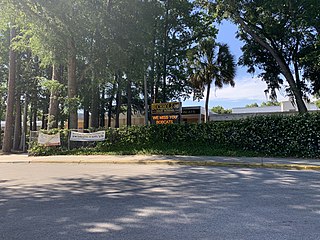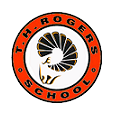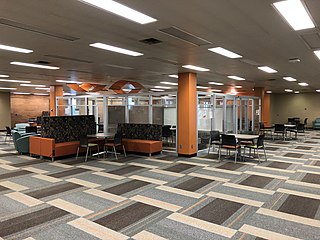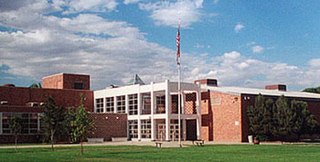Related Research Articles
The Cambridge School of Weston is an independent, coeducational high school in Weston, Massachusetts. Currently, the school has 325 students in grades 9 to 12, with approximately 70% day students and 30% boarding students.
A homeroom, tutor group, form class, or form is a brief administrative period that occurs in a classroom assigned to a student in primary school and in secondary school. Within a homeroom period or classroom, administrative documents are distributed, attendance is marked, announcements are made, and students are given the opportunity to plan for the day. Such periods also act as a form of Pastoral care, where teachers and administrators provide personal, social or health advice. Homerooms differ in their nature, depending on the country and the specific school.

F. W. Buchholz High School is a high school in Gainesville, Florida, United States. Buchholz is one of seven high schools in Alachua County. Opened in January 1971, it is the largest public high school in Gainesville, with 2,241 students in 2020. The Buchholz Math Team was dubbed "America's Greatest Math Team" by The Wall Street Journal in 2022, when Buchholz won first place for the 14th time in the annually held national Mu Alpha Theta math competition.
Northside College Preparatory High School is a public 4-year selective enrollment high school located in the North Park neighborhood on the north side of Chicago, Illinois, United States. Founded in 1999, it was the first new CPS high school to be built in 20 years. It is a selective enrollment school, and teaches only at the Honors and AP levels. Northside has earned a reputation for academic excellence, and has been consistently ranked as the #1 high school in Illinois by U.S. News & World Report.

Westside High School is the only high school of the Westside Community Schools district of Omaha, Nebraska, United States.

Thomas Horace Rogers School is an alternative primary and secondary public school and part of the Houston Independent School District. The school is at 5840 San Felipe in Houston, Texas, United States, outside of the 610 Loop and inside Beltway 8, west of Uptown Houston.

Alief Elsik High School is a high school in the Alief region of Houston, Texas, United States.
Dunbarton High School is located in Pickering, Ontario, Canada, and is part of the Durham District School Board. The school has students in grades 9-12 and offers a wide range of academic and extracurricular activities. Their mascot is the Spartan.

Pius XI High School is a private Catholic high school located in Milwaukee, Wisconsin. It is in the Roman Catholic Archdiocese of Milwaukee. Its enrollment is approximately 900.
Block scheduling or blocking is a type of academic scheduling used in schools in the American K-12 system, in which each pupil has fewer classes per day. It is more common in middle and high schools than in primary schools. Each class is scheduled for a longer period of time than normal. In one form of block scheduling, a single class will meet every day for a number of days, after which another class will take its place. In another form, daily classes rotate through a changing daily cycle.

Belmont High School is a four-year public high school in Belmont, Massachusetts, United States. The new school building was opened in 2021. The school had 1,309 students enrolled and a student/teacher ratio of 16.8:1 in the 2020–2021 school year.
Ursuline Academy is a four-year college-preparatory independent girls’ Catholic high school in Blue Ash, Ohio, United States. As of 2017, 658 students from all over Greater Cincinnati are enrolled in the school, representing 50 different ZIP codes.

Study hall, known as private study, SAS, structured study or free periods in the United Kingdom, is a term for a place to have a study time during the school day where students are assigned to study when they are not scheduled for an academic class. They are most commonly found in high schools and some middle schools, especially in the United States. In colleges, such a place may be called a student lounge. It is not to be confused with studying in a hallway.

Dundee-Crown High School is a high school located in Carpentersville, Illinois, United States, a northwest suburb of Chicago.

Edward H. White High School is a public high school operated by the Duval County Public Schools. It is located on the Westside of Jacksonville, Florida. It is almost exclusively referred to as "Ed White High School," not "White High School".

Brighton High School (BHS) is a secondary school located on South 8th Avenue in the heart of Brighton, Colorado, United States. It is one of three main high schools in the Brighton 27J School District,

Oceana High School is a small public high school in northern Pacifica, California. Offering an alternative college preparatory program, the school serves just over 600 students in grades nine through twelve. The school is one of five public schools in the Jefferson Union High School District. According to the State of California, Oceana is one of the twenty-five most diverse high schools in the state.
A school period is a block of time allocated for lessons, classes in schools. They typically last between 30 and 60 minutes, with around 3-10 periods per school day. However, especially in higher education, there can be many more. Educators determine the number and length of these periods, and may even regulate how each period will be used. One common example of this practice is to designate at least one compulsory period a day for physical education.

High school or senior high school is the education students receive in the final stage of secondary education in the United States. In the United States most high schoolers are ages 14-18. Most comparable to secondary schools, high schools generally deliver phase three of the ISCED model of education. High schools have subject-based classes. The name high school is applied in other countries, but no universal generalization can be made as to the age range, financial status, or ability level of the pupils accepted. In North America, most high schools include grades 9 through 12. Students attend them following graduation from middle school.
Legacy High School (LHS) is a public high school located in Bismarck, North Dakota. Legacy was founded following a $55 million bond approval in 2012, with students attending classes at other locations run by Bismarck Public Schools while the campus was under construction. Before Legacy was established, the last public high school to open in Bismarck was Century High School in 1975. The school has a graduation rate of 96%.
References
- ↑ Clark, Patricia; Saroyan, Phil (September 22, 2017). "Modular Scheduling OR Flex Scheduling OR Flexible Modular Scheduling OR Modular Flex Scheduling" (PDF). CCASN Master Schedule Guide. UC Berkeley Graduate School of Education.
- ↑ Darrow, Ralph, ed. (1999). Kent, Ohio: The Dynamic Decades. Kent, Ohio: Kent Historical Society. pp. 168–169.
- ↑ Gilkey, Susan Nicodemus; Hunt, Carla Herndon (2013). "Foreword". In Canady, Robert Lynn; Rettig, Michael D. (eds.). Teaching Mathematics in the Block. New York City: Routledge. p. v. ISBN 978-1-883001-51-3 – via Google Books.
- ↑ "Modular Schedule – Bell Schedule | Westside High School" . Retrieved 11 February 2019.
- ↑ Brookshire, Kay (May 14, 1971). "Layman New Principal of 'Covington Catholic'". The Cincinnati Enquirer (Kentucky ed.). Covington, Kentucky: Combined Communications. p. 24 – via Newspapers.com.
- ↑ IWHS. "Features of the Modular Schedule" (PDF). Archived from the original (PDF) on 2007-09-27. Retrieved 2007-06-19.
- ↑ "Daily Schedule". Legacy High School . Bismarck Public Schools. 2022. Retrieved 24 November 2022.
- ↑ "2022-23 Registration Guide.pdf" (PDF). Legacy High School . Bismarck Public Schools. 2022. Retrieved 25 November 2022.